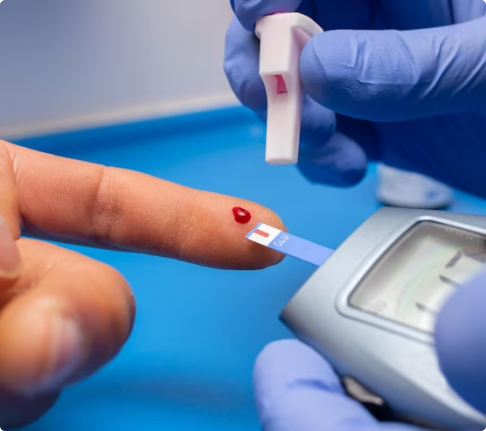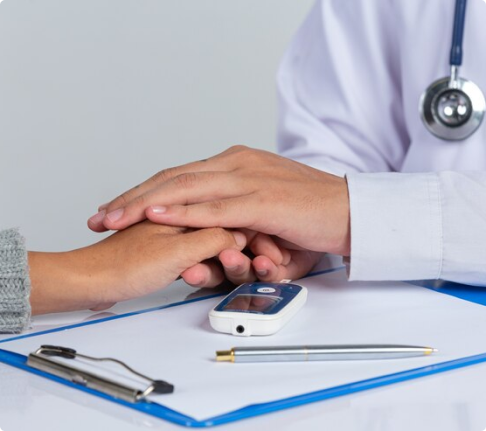- Visiting Hours: Mon-Sat / 8:00 AM - 8:00 PM
- Visiting Hours: Mon-Sat / 8:00 AM - 8:00 PM
- +91 80565 80565 / 044 46878787
Dr SM Rajendran has more than 40 years of experience. He completed his MBBS (1970) and MD (1978) from the University of Madras, and his Doctor of Science (DSc.) in 2012. He taught Internal Medicine and Diabetology at Stanley Medical College and served as Director and Professor of Diabetology at the Sree Balaji Diabetology Research Center, Chennai.
Mon – Sat / 9:00 AM to 1:00 PM
Type 1 diabetes refers to a condition where the body produces no insulin, or very little. It is an autoimmune disease, meaning the body’s immune system (that fights infections and keeps us healthy) attacks the pancreatic cells that produce insulin.
Insulin helps to move glucose—or the sugar absorbed by the body from the food we eat—from the blood to the cells. Here, the glucose is used by the body for energy production. Thus, without insulin, the sugar accumulates in the blood and causes various problems, leading to diabetes.
Type 1 diabetes has a genetic link and is seen in fewer people (only 10-15% of people with diabetes have type 1), but its onset is usually earlier. Symptoms appear during childhood or the teenage years and can progress rapidly within a few weeks. To be managed, the condition requires the individual to take continuous insulin supplementation. Thus, Type 1 diabetes affects the way the body processes sugar, requiring lifelong treatment.





Type 1 diabetes often presents in early adolescence with abrupt onset symptoms due to a rapid decline in insulin production. The common Type 1 diabetes symptoms include:
In advanced cases, individuals can present with diabetic ketoacidosis (DKA), characterized by abdominal pain, nausea, vomiting, and fruity-smelling breath.
It is essential to recognize the symptoms and seek immediate care, especially in children and young adults. Prompt medical attention is crucial to prevent life-threatening complications. An early diagnosis can be sought through blood tests measuring glucose and other biomarkers.



An autoimmune disease, Type 1 diabetes is caused when the body’s immune system, which usually fights infections, marks the insulin-producing pancreatic cells as foreign bodies. It attacks and destroys the cells, disrupting and halting insulin production in the pancreas. Without insulin to guide blood glucose into cells, the level of sugar in the blood rises rapidly. This condition is termed a hyperglycaemic state and can lead to various short- and long-term effects in the organs, including the heart, kidneys, nervous system, eyes, gums, etc.
In Type 1 diabetes, the body’s immune system attacks and destroys insulin-producing beta cells in the pancreas, leading to absolute insulin deficiency. Insulin replacement therapy is essential for regulating blood sugar levels and preventing complications. Without insulin, the cells cannot absorb glucose, resulting in high blood sugar and metabolic imbalances.


Glucose is the ultimate end product of digestion, ensured by the breakdown of complex carbohydrates by the digestive enzymes from the gut.
This is then used by the cells to produce Adenosine triphosphate (ATP), which is the energy source used by our bodies to perform all processes. Glucose is the primary and best source for producing energy molecules, as carbohydrates are converted quickly, and efficiently, compared to proteins and fats.
Family history is the primary identifiable risk factor of Type 1 diabetes; the other main risk factors are age, genetic inheritance, and ethnicity.
If an immediate or close family member has diabetes, then symptoms of Type 1 diabetes usually appear around the teens. However, recent studies show that rare symptoms and the disease onset can occur at any age




Prevention is always better than cure. We perform routine physical and wellness check-ups to ensure that any disease is detected and treated in its initial stages.



Family history is a critical factor in Type 1 diabetes. An X chromosome-linked genetic inheritance characterizes diabetes, so it usually runs in families.
If an individual’s immediate family member has diabetes, the chances of them getting the disease increase. That is, if you have a mother, father, sister, or brother with diabetes, you are more likely to be diabetic or prediabetic. It is recommended that
The potential complications of Type 1 diabetes include:



Type 1 diabetes cannot be prevented, as it is primarily an immune-mediated and inherited disease. To manage the condition, individuals with Type 1 diabetes can follow a healthy lifestyle, exercise regularly, and strictly regulate their sugar intake.
Type 1 diabetes is a lifelong disease and needs continuous external insulin supply along with other medications as prescribed. It is recommended to focus on reducing adverse effects and stopping the disease progression by adhering to a daily regimen.
A healthy lifestyle is needed to lower blood sugar and maintain body weight, along with regular monitoring of the condition by a diabetologist.
If you know that a close family member has Type 1 diabetes, it is best to consult a doctor as early as possible. It is crucial not to wait for the appearance of symptoms to get medical attention and rule out a diagnosis.
If you notice any symptoms commonly associated with diabetes that persist for a week or more, contact your doctor immediately and take the appropriate laboratory tests as recommended.





The leading cause of diabetes is the inability of the pancreas to produce insulin. So, the primary treatment for diabetes is supplying the body with insulin to process the sugar in food. This external insulin supply can be provided in several ways, such as injections and insulin pumps. Individuals with diabetes can also access long-term blood sugar monitoring systems, which use sensor patches on the skin to detect when and what dose of insulin is required.
The most critical steps for diabetes management involve changes in diet and lifestyle and include the following:



For individuals managing Type 1 diabetes, maintaining low blood sugar levels is crucial. The best diets for Type 1 diabetes focus on regulating blood sugar while ensuring balanced nutrition. Some widespread dietary changes are:
Carbohydrate counting: This involves low-carb meals or cutting carbs in every meal. Consistency in carbohydrate intake helps manage insulin doses more effectively. The focus is on consuming whole grains, fruits, vegetables, and legumes that are digested more slowly.
Mediterranean diet: This emphasizes fruits, vegetables, whole grains, lean proteins (such as fish and poultry), and healthy fats (like olive oil and nuts). This diet can help enhance blood sugar control and cardiovascular health.
DASH diet: Preferred for its effectiveness in lowering blood pressure, the Dietary Approaches to Stop Hypertension (DASH) diet promotes the intake of fruits, vegetables, and lean proteins and eliminating salt. It contributes to better overall health, potentially aiding blood sugar control.
Low-glycaemic index (GI) diet: This diet focuses on foods with a lower impact on blood sugar levels, such as whole grains, non-starchy vegetables, legumes, and certain fruits. It can contribute to more stable blood sugar management.
Consistent meal timing: Regular meals and snacks spaced throughout the day can assist with maintaining steady blood sugar levels, preventing sudden spikes or drops.
Some other diets often considered for diabetes management are weight watchers, paleo, gluten-free, vegan, and alkaline diets. It’s crucial to consult with a registered dietitian or a healthcare professional to personalize a diet plan that aligns with your body’s needs, considering factors like insulin dosage, lifestyle, age, personal taste, co-morbid conditions, and costs.





For individuals with diabetes, daily exercise is recommended, with outdoor exercise preferred over indoor exercise. No one type of physical activity fits everyone, but brisk walking, jogging, running, cycling, swimming, and aerobics are recommended over lifting weights and strength training.
Resistance exercises are also an excellent way to lose weight and burn calories. Regular exercise has benefits for those with diabetes, such as:
The goal of exercise for individuals with diabetes is to keep body weight at the optimum level while also burning calories to maintain blood sugar levels. Indoor activities at the gym and floor-based workouts are not discouraged. However, they have been found to be less effective in controlling weight, especially as most workouts are designed to bulk up and build muscle mass.
No matter the specific exercise regimen, consistency is the key, and intense, high-exertion daily activities for short periods are preferred over low-intensity workouts throughout the day. Engaging in a mixture of physical activities, such as playing sports, walking, lifting weights, etc., can help the mind and body to focus and work different muscle groups while eliminating routine.



All people with diabetes and prediabetes are advised to take blood sugar tests regularly.
All tests and their frequency are decided by a doctor based on the patient’s age, body condition, access to healthcare, and severity of the disease.


Would you like to manage your diabetes better and lead a healthier, normal life?
Take an appointment with our senior diabetologist today!


No 6, 6th Main Road, Opp. Indian Bank. Nanganallur, Chennai - 600061
+91 80565 80565 / 044 46878787
contact@dihaclinic.org
Mon - Sat / 8:00 AM - 8:00 PM
 Vishnu Rajan2024-06-03Highly recommended for the services provided here; Excellent ambience; clean and hygienic area where the medical procedures are performed; kind medical and non-medically staffs; Bonus points for the kids-area. Keep up the good work.
Vishnu Rajan2024-06-03Highly recommended for the services provided here; Excellent ambience; clean and hygienic area where the medical procedures are performed; kind medical and non-medically staffs; Bonus points for the kids-area. Keep up the good work. Gopalachari Ramarajan2024-05-31Sir Madam I am very much happy about the hospital check up to my highest satifasfaction Staffs doctors very much responsive well attending needs to the patients more over hospital are well maintained neat n clean the rates for the tests are not high compare to other hospitals.
Gopalachari Ramarajan2024-05-31Sir Madam I am very much happy about the hospital check up to my highest satifasfaction Staffs doctors very much responsive well attending needs to the patients more over hospital are well maintained neat n clean the rates for the tests are not high compare to other hospitals. dharmarajan viswanathan2024-05-25We had a good consultation and advice from Dr.Rajendran. His patient hearing and observation from the file really good. He creates confidence that is what most doctors now don't do it. His approach is so nice. We will recommend this doctor and clinic
dharmarajan viswanathan2024-05-25We had a good consultation and advice from Dr.Rajendran. His patient hearing and observation from the file really good. He creates confidence that is what most doctors now don't do it. His approach is so nice. We will recommend this doctor and clinic Natarajan Subramanian2024-05-16I recently had the pleasure of visiting Sudha ma'am at Diha clinic for my thyroid concerns. From the moment I walked in, the atmosphere was warm and welcoming, which immediately put me at ease. The staff was friendly and efficient, making the entire process seamless. Sudha maam was excellent and she took the time to listen to my concerns and answer all of my questions, never making me feel rushed. Thanks to Dr. Sudha Balasubramnian's guidance and treatment plan, I've seen significant improvements in my thyroid health. Overall, my experience at Diha was exceptional
Natarajan Subramanian2024-05-16I recently had the pleasure of visiting Sudha ma'am at Diha clinic for my thyroid concerns. From the moment I walked in, the atmosphere was warm and welcoming, which immediately put me at ease. The staff was friendly and efficient, making the entire process seamless. Sudha maam was excellent and she took the time to listen to my concerns and answer all of my questions, never making me feel rushed. Thanks to Dr. Sudha Balasubramnian's guidance and treatment plan, I've seen significant improvements in my thyroid health. Overall, my experience at Diha was exceptional Lakshminarasimhan lanhan2024-05-15It is a well maintained clinic with expert doctors in all faculties. The NABL attached pathological lab is managed well by experts in the field. The ambience adds a feel good factor that is sure too assure the patients to get well. The pharmacy attached dispenses all medicines and the patients need not run hither and thither. The front-office personnel are very receptive and assist the patient in the best way they can. Systems are in place, therefore, the prescriptions given are all neatly printed. I pray good health for all through their life, but we are bound to get sick and if such a situation befalls, you can just walk into Diha clinic at Nanganallur for treatment. Stay blessed Stay healthy. Kudos to Team Diha Clinic, Nanganallur, Chennai -600061
Lakshminarasimhan lanhan2024-05-15It is a well maintained clinic with expert doctors in all faculties. The NABL attached pathological lab is managed well by experts in the field. The ambience adds a feel good factor that is sure too assure the patients to get well. The pharmacy attached dispenses all medicines and the patients need not run hither and thither. The front-office personnel are very receptive and assist the patient in the best way they can. Systems are in place, therefore, the prescriptions given are all neatly printed. I pray good health for all through their life, but we are bound to get sick and if such a situation befalls, you can just walk into Diha clinic at Nanganallur for treatment. Stay blessed Stay healthy. Kudos to Team Diha Clinic, Nanganallur, Chennai -600061 Nalini R2024-04-27Dr Sudha is such a friendly person and listens to our problems with patience. Hospital staffs are very polite and easily approachable. Ambience is very good and the rest rooms are maintained in a very hygienic manner. I would recommend Diha clinic for any health concerns.
Nalini R2024-04-27Dr Sudha is such a friendly person and listens to our problems with patience. Hospital staffs are very polite and easily approachable. Ambience is very good and the rest rooms are maintained in a very hygienic manner. I would recommend Diha clinic for any health concerns. google user2024-04-27Excellent facilities, very neatly maintained, and the doctors and clinic staff are very kind and helpful.
google user2024-04-27Excellent facilities, very neatly maintained, and the doctors and clinic staff are very kind and helpful. Balan L S2024-04-22Consulted Dr Niranjanan and his approach, consult and describing medicines are very suitable to us. We are just satisfied with the service of Diha Clinic.
Balan L S2024-04-22Consulted Dr Niranjanan and his approach, consult and describing medicines are very suitable to us. We are just satisfied with the service of Diha Clinic.
No 6, 6th Main Road, Opp.Indian Bank. Nanganallur, Chennai - 600061
Copyright © 2024 Diha Clinic. All rights reserved | Designed by Spidergems